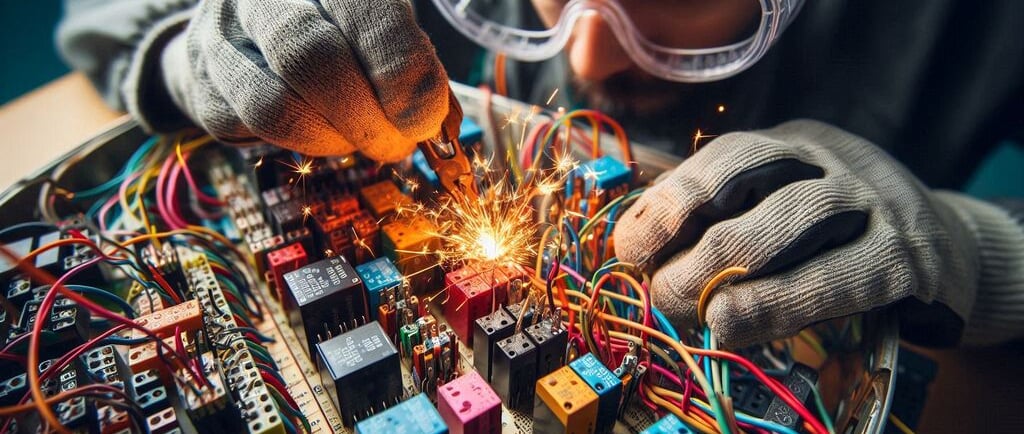Relays and Fuses
Electrical systems in vehicles, homes, and various machinery are complex, but certain components play crucial roles in ensuring everything runs smoothly and safely.
ELECTRICAL SYSTEMS
11/14/20244 min read


Understanding Relays and Fuses: Essential Components of Your Electrical System
Electrical systems in vehicles, homes, and various machinery are complex, but certain components play crucial roles in ensuring everything runs smoothly and safely. Among these, relays and fuses are essential parts that protect electrical circuits and components from damage. While they may be small in size, their function is significant in preventing larger, more expensive issues.
In this article, we’ll explore how relays and fuses work, their importance, and how you can maintain them to ensure the longevity and efficiency of your electrical systems.
What are Relays?
A relay is an electrically operated switch used to control a high-voltage circuit with a low-voltage signal. When an electrical current is passed through the relay's coil, it generates a magnetic field that causes the switch to open or close. Relays are widely used in automotive, industrial, and residential applications for controlling lights, motors, and other electrical devices.
Key Functions of Relays
Switching Power: Relays allow a low-power signal to control higher-power electrical devices, which is crucial for minimizing the amount of power needed for a given operation.
Safety: In many cases, relays are used in safety circuits to cut off power in the event of a fault or malfunction, such as in automotive systems where they can disconnect the battery if there’s a short.
Time Delay: Some relays incorporate a time delay function, allowing specific circuits to activate after a certain time has passed, such as in cooling systems.
Common Uses of Relays
Automotive Systems: Relays are used to control headlights, fans, power windows, and other systems in vehicles.
Home Appliances: In home heating and cooling systems, relays control when a furnace or air conditioning unit turns on or off.
Industrial Equipment: Relays help control large motors and equipment in factories or power plants, ensuring safe and efficient operation.
What are Fuses?
A fuse is a safety device that protects an electrical circuit from damage caused by excess current. It works by breaking the circuit when the current exceeds a certain level, preventing overheating, fires, or other damage to the electrical components. Fuses are designed to "blow" (or melt) when they detect an overload, disrupting the flow of electricity and stopping potential damage.
Key Functions of Fuses
Overload Protection: Fuses protect wiring, circuits, and electrical devices from overheating due to excess current, helping to avoid fires or further electrical issues.
Circuit Safety: When a fuse blows, it disconnects the power, protecting the device or system it serves.
Prevent Damage to Sensitive Components: Fuses help ensure that sensitive devices such as computers or TVs don’t get damaged due to voltage surges or short circuits.
Types of Fuses
There are several types of fuses designed for different applications:
Blade Fuses: Common in automotive systems, these fuses come in various amperage ratings and are designed to easily pop out of the circuit when overloaded.
Glass Tube Fuses: Used in household appliances, these fuses have a thin glass casing and are available in various sizes.
Cartridge Fuses: Typically found in industrial applications, these fuses are larger and offer higher power ratings for heavy-duty circuits.
Relays vs. Fuses: What's the Difference?
While both relays and fuses play critical roles in protecting electrical systems, they serve very different functions.
Relays:
Function: A relay acts as a switch, allowing a low-voltage signal to control a high-voltage circuit.
Purpose: They are used for controlling and switching electrical devices on and off.
Failure Mode: When a relay fails, it may result in the device failing to turn on or off, but it typically does not cause damage to the system itself.
Fuses:
Function: A fuse acts as a protective device that breaks the circuit when an overload or short circuit occurs.
Purpose: Fuses are used to protect circuits and components from damage due to excessive current.
Failure Mode: When a fuse blows, it disconnects the power, requiring replacement to restore the circuit.
How to Maintain Relays and Fuses
Proper maintenance of relays and fuses is essential for ensuring the safety and longevity of your electrical systems. Here are some practical tips to help you maintain these components:
1. Inspect Regularly
Both relays and fuses should be inspected periodically. Look for signs of wear, corrosion, or damage. If a fuse has blown, check the circuit for underlying issues before replacing it.
2. Use Correct Ratings
Ensure that fuses and relays are rated for the correct voltage and current for your specific system. Using the wrong rating can cause failure or ineffective protection.
3. Replace Blown Fuses Immediately
If a fuse blows, replace it with a new one of the same type and amperage rating. Never bypass a blown fuse as this could lead to damage or even fire.
4. Clean and Protect Relays
Relays should be kept clean and free from moisture, dirt, and corrosion. Regularly check for any signs of electrical arcing or overheating.
5. Address Overload Issues
If you experience frequent blown fuses or relays failing, it’s important to investigate whether the system is overloaded. Excessive electrical demand can cause repeated failures, so ensure circuits are balanced properly.
Common Signs of Relay and Fuse Issues
Knowing the signs of failing relays and fuses can help you avoid bigger problems down the road. Look for these symptoms:
Relays: Unresponsive electrical components, overheating, or irregular operation.
Fuses: Burned out or discolored fuses, electrical components not functioning, or intermittent issues with power supply.
Conclusion: Keeping Your Electrical System Safe and Efficient
Both relays and fuses are essential for the safety and efficiency of your electrical systems. By understanding their roles and maintaining them properly, you can avoid costly repairs and ensure that your systems run smoothly. Regular inspection and timely replacement of these components are key to keeping your electrical devices protected from overloads and damage.



